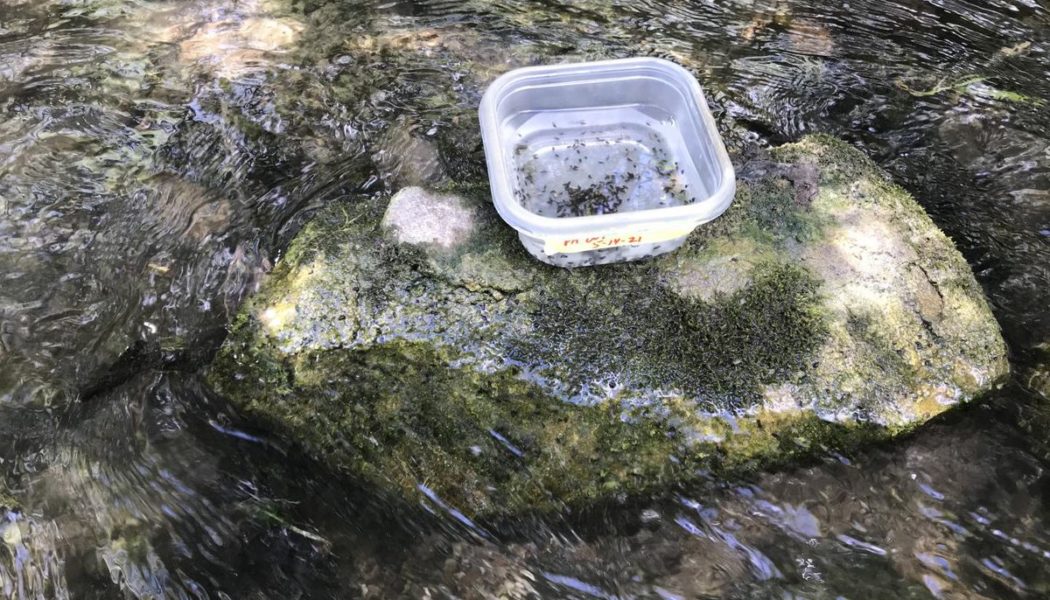DNA sleuthing helped scientists spot early outcrops of a spreading snail invasion in Pennsylvania. The method could be used to spot the unwanted critters before they cause serious damage. That way, conservationists can stop them from conquering even more places.
New Zealand mud snails became a global pest in part because they can reproduce asexually — just one snail in a new area can essentially clone itself until there are 500,000 snails in a single square yard. They’re about the length of a pencil eraser so they’re hard to find until there are so many in a location that it’s nearly impossible to stop their spread.
“It’s kind of weird because as an invasive ecologist, I never really want to find this thing,” says Edward Levri, a Pennsylvania State University-Altoona professor and senior author of a new study published this week in the journal Biological Invasions. “It’s sort of an exciting feeling, it opens the door for us to be able to use this technology to detect the snail at a much wider scale.”
Levri and his colleagues successfully used DNA present in the environment (something researchers call environmental DNA or eDNA) to track down the tiny snails. But over the past decade, Levri has spent a lot of time looking for the tiny rascals by turning over rocks and casting nets. “It is an arduous process, and there’s very limited success,” he tells The Verge.
So this time, he worked with the lead study author James Woodell to collect water samples from eight different locations across Pennsylvania and scour them for the snails’ DNA. Just like humans slough off skin cells in the shower, snails shed DNA in the water. The researchers used a technique called a polymerase chain reaction, or PCR, to amplify small amounts of snail DNA found in water samples. They use a dye to make the DNA glow so that it can be spotted with a special machine.
:no_upscale()/cdn.vox-cdn.com/uploads/chorus_asset/file/22554398/265895_web.jpeg)
They ultimately found eDNA from the mud snails in five of the eight locations they sampled. Levri has since been able to go back and find an actual New Zealand mud snail at one of those locations. He hasn’t yet found the snails at the other locations — he hasn’t been able to be out in the field as much as he’d like because of the pandemic. While there’s a possibility that some of the eDNA drifted there from other locations, Levri and co-authors hope the state will consider the eDNA findings as enough evidence to take action.
“From the conservation perspective, that’s enough to say, ‘Hey, we should really be more careful with these sites,” says Maurine Neiman, an associate professor of biology at the University of Iowa and another one of the authors of the study.
The snails are small enough to hitch a ride on fishing gear unnoticed, which is one way they’ve been able to spread across the US and other parts of the world (they can also tag along on boats). The state could put signs up to warn people who fish at these locations to take extra precautions, like cleaning their waders with certain disinfectants before they visit a new fishing location (sticking them in the freezer overnight accomplishes the same thing).
The New Zealand mud snail was first found in Pennsylvania in 2013 at Spring Creek, and now there are “millions” there, according to Levri. That’s bad news for the area’s fish and the people who like to catch them. The snails are difficult to digest and have been known to come out the other end of a fish alive after being eaten. Since they’re a poor source of nutrition, studies have shown that fish that eat them lose weight. The snails also crowd out native snails and aquatic insects. In some cases, the invasive snails make up 90 percent of the invertebrate biomass in a location. That’s “amazing for just one species to do,” says Levri.
“These snails are tiny, but they seem to have the potential to pack a really big ecological punch to these invaded ecosystems,” Neiman says.
eDNA could help researchers find the snails a year or more sooner than they otherwise might have. That gives conservationists crucial time to stop the snails before people unwittingly give them a ride to other, snail-free locales. Conservationists haven’t been very successful in getting rid of the snails once they’ve shown up, Levri says, so that’s all the more reason to stop their spread in the first place.










